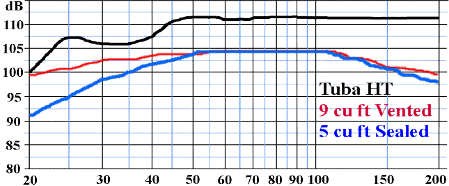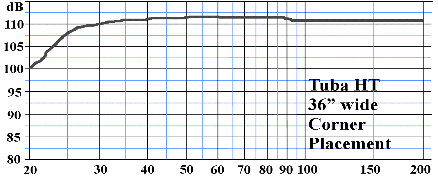@thespeakerdude wrote:
Have you been following what I said I do? Speakers for professional applications? Do you think that just means studio speakers? @donavabdear mixes for movies where you are trying to "recreate" real dynamic events.
And your point is? @donavabdear made no effort to limit his views on dynamics to a given application of reproduction, but rather made a broad statement. I replied accordingly. To most here it’s about home audio reproduction. Dynamics should apply as one sees fit, however setting the bar high here isn’t some fad but rather acting on a hugely important aspect of music (and movie) reproduction. That it isn’t a higher priority has more to do with spousal demands and interior decoration (and even vanity) than a conscious "no thanks."
20CuFt is not really enough for a proper horn loading at 20Hz.
You wrote ".. a real horn loaded speaker at 20Hz," and I’m telling you a 20cf. quarter wave tapped horn with a tune a ~22Hz will do honest and proper 20Hz - period. What isn’t proper is asking a smaller size, lower eff. direct radiator doing the same, even with a surplus of power. And horn sub iterations can be in multiples as well.
Tell me @phusis, what is your personal definition of "dynamics"?
Let me put it this way: my take on dynamics is they matter more than many if not most audiophiles care to pursue via their home setup. Which brings me to your next question..
What is a sufficient peak db level?
To me "sufficient" peak dB level is a max. required SPL number with some +20dB’s of added headroom. A pair of corner placed (i.e.: with boundary gain) high eff. tapped horn subs and high eff. pro cinema main speakers with a combined 2.3kW actively per channel can shell out +125dB’s at the LP (~11ft. listening distance), full-range, so backwards math gives an easy 105dB’s with +20dB’s of headroom - within my actual required range.
Please note that I don’t blast my ears with +110dB peaks like a daily meal, if rarely at all. However, an abundance of full-range headroom provides wholly effortless, low distortion playback that few get to experience, even at levels that are downright physical in nature. The clean (and full-range) dynamic bandwidth not least comes in handy with Blu-ray/4K UHD playback of movies.
I could go on about describing this, but it really requires of one to experience it first-hand to know it. Suffice to say that when you have a bunch of high eff., large diameter transducers (or force multiplied via acoustic transformation) that move very little, yet while producing tremendous SPL’s at the LP, it can provide a very relaxed, full and immersive feel of sound that’s simply not attainable from smaller, low eff. speaker packages.
Coming down to it it’s really about the benchmark I’ve set out to go by within a range of core parameters, and has come to achieve in some measure. ’Core parameters’ may not apply similarly to all, and a MFR rarely has the luxury to go all-out in regards to core physics of reproduction, for reasons already outlined by you. Fortunately DIY and an open approach to which segment of gear is used can change that, relatively uninhibited.
What is a peak db level listening to an orchestra say 10 rows from the stage?
10th row with a large symphony orchestra during tutties? I’d say 105-110dB’s.
How often are you trying to recreate a Saturn V launch?
I don’t, really, and you obviously missed my point. Another example, here from the world of cars, and to hopefully get through with my point this time around: if, say, a Formula car is your effective out-of-reach reference, then for sure a Porsche 911 Carrera GTS is still faster than a Citroen Berlingo, and who among fast-car aficionados wouldn’t appreciate that difference in performance - even without achieving the speed of an F1 racer? Moreover, you’d certainly get a closer feel of what it means driving F1.



